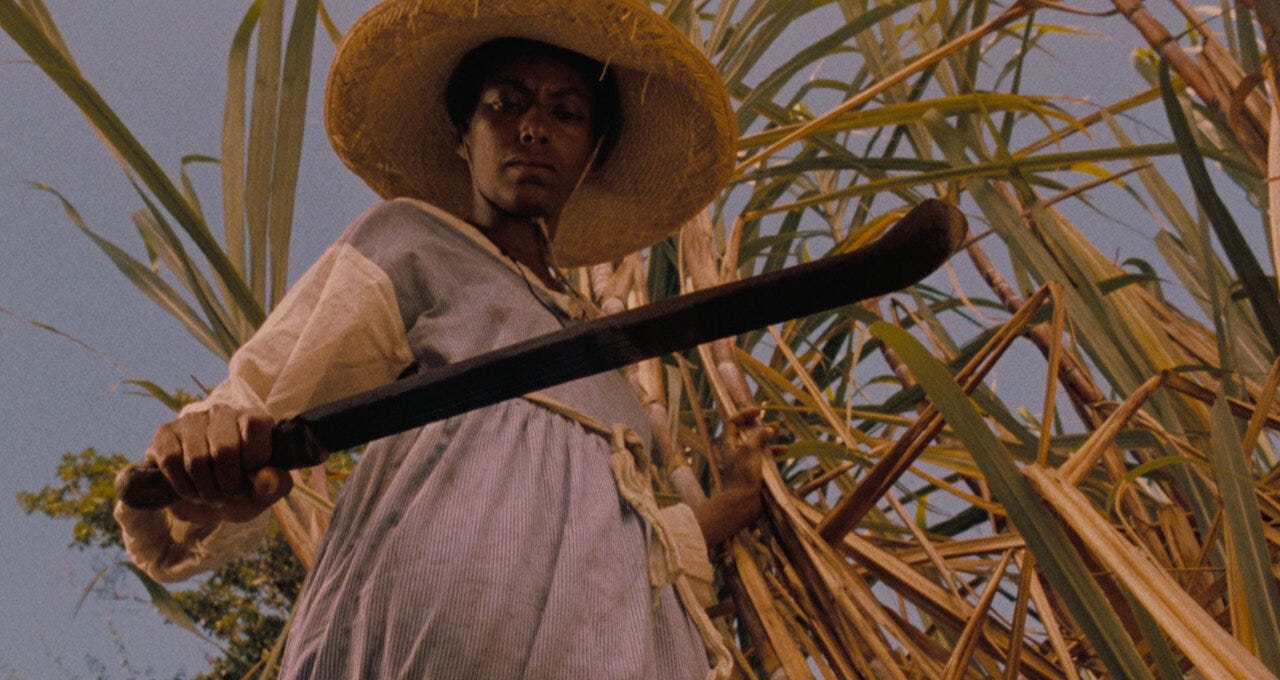What to Watch This Weekend 10/8/21
A Black American classic on Netflix; Daniel Craig says goodbye to Bond in theaters

The Nut Graff: The 1993 classic “Sankofa” (****) brings Haile Gerima’s uncompromising vision to VOD; “No Time to Die” (***1/2) is the last Daniel Craig James Bond movie and — surprise — one of the best.
Trying to find a decent movie on Netflix is like crate-diving at a used-record store — every once in a blue moon you pull up vintage wax. I have no idea how Haile Gerima’s 1993 “Sankofa,” a classic of Black American cinema, ended up on the service next to “Seinfeld” reruns and “Squid Game,” and I don’t really care, so long as people get to watch this timeless fable about America’s slave-holding past and its grip on the present. If you need further endorsement, “Sankofa” has been included on a Harvard list of 500 essential movies, and its recent restoration and rerelease was bankrolled by filmmaker Ava DuVernay (“Selma,” “13th”). Whether or not DuVernay helped broker the Netflix deal as well, “Sankofa” is now available to the widest streaming audience possible.

The storyline is oddly similar to that of last year’s “Antebellum,” but without that film’s glib “Twilight Zone” ending. (It also owes a bit to Octavia Butler’s 1979 novel “Kindred.”) An American model named Mona (Oyafunmike Ogunlano, above), shooting a fashion spread at the notorious Cape Coast Castle on the coast of Ghana, finds herself mysteriously transported back through time. From that embarkation point for the Slave Triangle, she is whisked to a Louisiana plantation in the early 19th century, where Mona is reimbodied as a house slave named Shola. The movie charts the main character’s emotional, spiritual, and moral journey from rootless hedonism – “I’m an American!” Mona protests as she’s carried off by slave traders at the castle – through complacent denial at Shola’s (relatively) comfortable place in the plantation hierarchy to a climactic act of resistance, prompted by her relationship with Shango, a rebellious field slave played by the Jamaican singer-poet Mutubaraka, and by a serene Ghanaian mother figure named Nunu (Alexandra Duah).

“Sankofa” includes scenes of rape, whippings, and murder, but where a movie like “12 Years a Slave” holds a viewer’s feet to the fires of its atrocities, Gerima stands slightly further back. He wants to document rather than sensationalize, and he’s more interested in the complex interplay within the community of slaves, from the ferocious Shango to the hesitant Shola to Joe (Nick Medley), Nunu’s son by a white slaver and a headman who has bought ruinously into the myths of white supremacy. The movie has a dreamlike tone that veers from the lyrical to the harsh and back again, and the director consciously bookends his story with sequences of a village elder (played by the late, great Ghanaian drummer Kofi Ghanaba, a.k.a. Guy Warren) invoking the past to come teach the present a lesson. It’s a film that seems ancient and wise.
Gerima was born in Ethiopia in 1946 but came to the U.S. in 1967 to study theater in Chicago; he moved to Los Angeles in 1970 and became part of a movement alternately known as the L.A. Rebellion, the UCLA Rebellion, and the Los Angeles School of Black Filmmakers. Colleagues included such storied directors as Charles Burnett (“To Sleep With Anger”) and Julie Dash (“Daughters of the Dust”), and with his breakthrough feature “Bush Mama” (1976), Gerima joined their ranks. He taught film at Howard University for decades before retiring recently and served as a mentor to countless young filmmakers, including DuVernay, who spearheaded both the rerelease of “Sankofa” and a concurrent career retrospective at the new Academy Museum of Motion Pictures. (An ornery and excellent recent Vanity Fair interview can be found here.) He’s a great American filmmaker who finds meaning and strength in the tragedy of African diaspora.
A few quick words about “No Time to Die,” the fifth and final Daniel Craig James Bond movie that finally opens in theaters today after a year and a half of pandemic-related postponements. You may go into it thinking it’s time for Bond to retire already, and in a sense that’s exactly what you get. But I was surprised and pleased by how well this entry – the 26th if you don’t count 1967’s goofball version of “Casino Royale” – honors the compact the series has made with audiences over the decades while retooling it for today. The classic elements are handled with style and wit – the Aston-Martin, the martini shaken not stirred, a villain (gecko-eyed Rami Malek) and a doomsday device that, for once, are both genuinely terrifying – while the “Bond girls” (Lashana Lynch as a new double-O, Ana de Armas as a Cuban spy) have been upgraded from bed-able arm-candy to collegial action heroes in a way that’s fun rather than forced. In scope and stunts and hype, the Bond series has started to blur with the other big action franchises: The Tom Cruise “Mission Impossible” movies, the “Bourne” series with Matt Damon — even the never-ending “Fast and Furious” saga. It’s extremely satisfying, therefore, to see Craig bow out by reminding everyone what made 007 the class act of the bunch.

It matters, I think, that the director, Cary Joji Fukanaga, has proved himself in both independent films (“Sin Nombre”) and series TV (HBO’s “True Detective”) and that before a rather gray and formulaic final act “No Time to Die” is at times beautiful to look at. It matters, too, that the writers include Phoebe Waller-Bridge, of TV’s “Fleabag,” and I bet you can spot her contributions in the form of dialogue that feels as if it’s been turned on a lathe. Now all you have to do is decide whether it’s worth the risk to see “No Time to Die” in a movie theater. On one hand, the Italian city of Matera and other global locations are gob-stopping on the big screen, as are the car chases, foot chases, and fisticuffs that unfold in them. On the other hand, there is that title.
If you enjoyed this edition of Ty Burr’s Watch List, please feel free to share it with friends.
If you’re not a paying subscriber and would like to sign up for additional reviews and commenting, here’s how:
If you’re already a paying subscriber, I genuinely thank you for your support.





